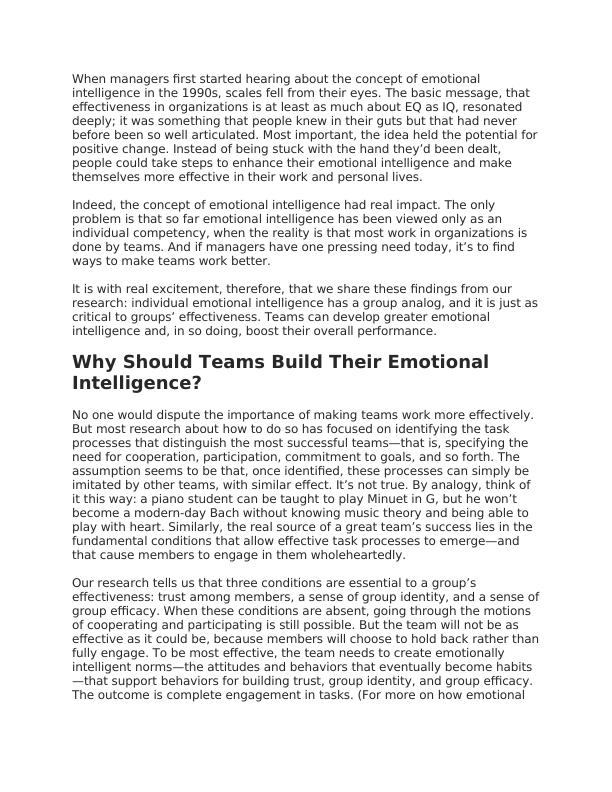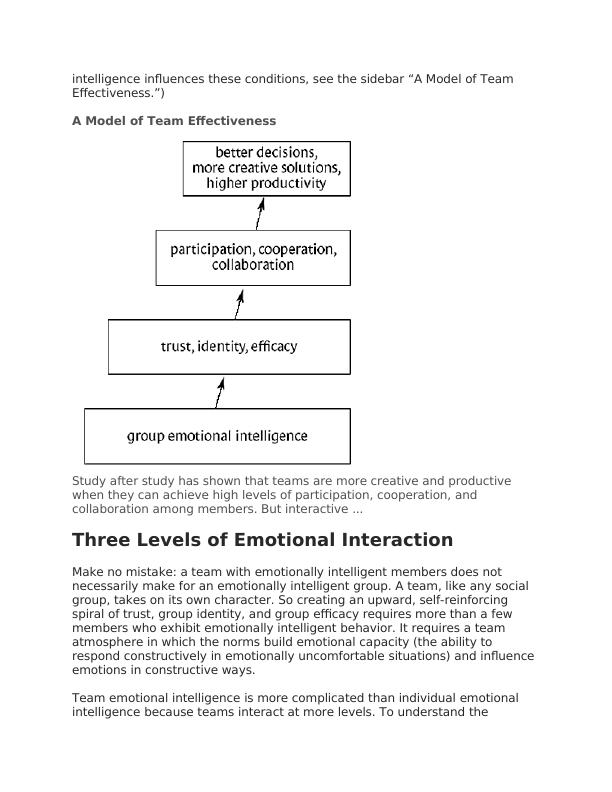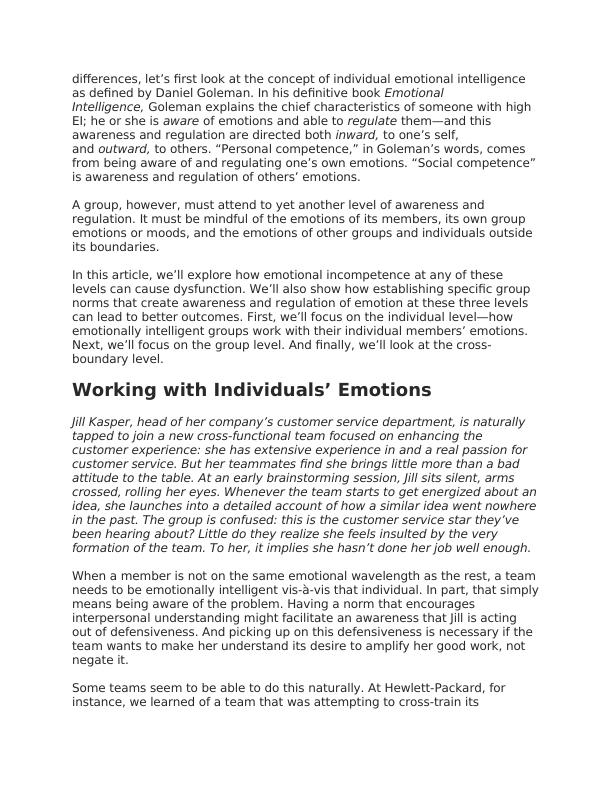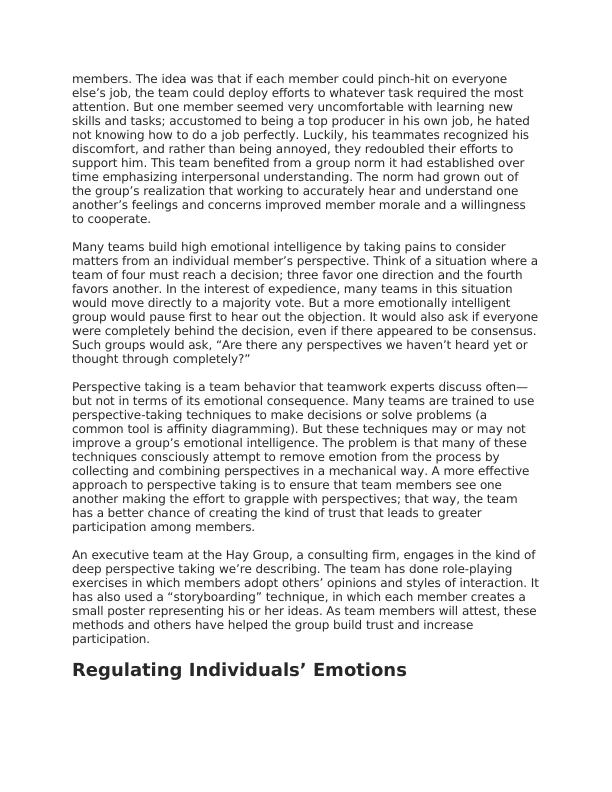Ask a question from expert
Create Emotionally Intelligent Teams (pdf)
15 Pages6576 Words105 Views
Added on 2021-06-22
Create Emotionally Intelligent Teams (pdf)
Added on 2021-06-22
BookmarkShareRelated Documents
When managers first started hearing about the concept of emotional intelligence in the 1990s, scales fell from their eyes. The basic message, that effectiveness in organizations is at least as much about EQ as IQ, resonated deeply; it was something that people knew in their guts but that had never before been so well articulated. Most important, the idea held the potential forpositive change. Instead of being stuck with the hand they’d been dealt, people could take steps to enhance their emotional intelligence and make themselves more effective in their work and personal lives.Indeed, the concept of emotional intelligence had real impact. The only problem is that so far emotional intelligence has been viewed only as an individual competency, when the reality is that most work in organizations is done by teams. And if managers have one pressing need today, it’s to find ways to make teams work better.It is with real excitement, therefore, that we share these findings from our research: individual emotional intelligence has a group analog, and it is just ascritical to groups’ effectiveness. Teams can develop greater emotional intelligence and, in so doing, boost their overall performance.Why Should Teams Build Their Emotional Intelligence?No one would dispute the importance of making teams work more effectively. But most research about how to do so has focused on identifying the task processes that distinguish the most successful teams—that is, specifying the need for cooperation, participation, commitment to goals, and so forth. The assumption seems to be that, once identified, these processes can simply be imitated by other teams, with similar effect. It’s not true. By analogy, think of it this way: a piano student can be taught to play Minuet in G, but he won’t become a modern-day Bach without knowing music theory and being able to play with heart. Similarly, the real source of a great team’s success lies in the fundamental conditions that allow effective task processes to emerge—and that cause members to engage in them wholeheartedly.Our research tells us that three conditions are essential to a group’s effectiveness: trust among members, a sense of group identity, and a sense ofgroup efficacy. When these conditions are absent, going through the motions of cooperating and participating is still possible. But the team will not be as effective as it could be, because members will choose to hold back rather thanfully engage. To be most effective, the team needs to create emotionally intelligent norms—the attitudes and behaviors that eventually become habits—that support behaviors for building trust, group identity, and group efficacy. The outcome is complete engagement in tasks. (For more on how emotional

intelligence influences these conditions, see the sidebar “A Model of Team Effectiveness.”)A Model of Team EffectivenessStudy after study has shown that teams are more creative and productive when they can achieve high levels of participation, cooperation, and collaboration among members. But interactive ...Three Levels of Emotional InteractionMake no mistake: a team with emotionally intelligent members does not necessarily make for an emotionally intelligent group. A team, like any social group, takes on its own character. So creating an upward, self-reinforcing spiral of trust, group identity, and group efficacy requires more than a few members who exhibit emotionally intelligent behavior. It requires a team atmosphere in which the norms build emotional capacity (the ability to respond constructively in emotionally uncomfortable situations) and influence emotions in constructive ways.Team emotional intelligence is more complicated than individual emotional intelligence because teams interact at more levels. To understand the

differences, let’s first look at the concept of individual emotional intelligence as defined by Daniel Goleman. In his definitive bookEmotional Intelligence,Goleman explains the chief characteristics of someone with high EI; he or she isawareof emotions and able toregulatethem—and this awareness and regulation are directed bothinward,to one’s self, andoutward,to others. “Personal competence,” in Goleman’s words, comes from being aware of and regulating one’s own emotions. “Social competence” is awareness and regulation of others’ emotions.A group, however, must attend to yet another level of awareness and regulation. It must be mindful of the emotions of its members, its own group emotions or moods, and the emotions of other groups and individuals outside its boundaries.In this article, we’ll explore how emotional incompetence at any of these levels can cause dysfunction. We’ll also show how establishing specific group norms that create awareness and regulation of emotion at these three levels can lead to better outcomes. First, we’ll focus on the individual level—how emotionally intelligent groups work with their individual members’ emotions. Next, we’ll focus on the group level. And finally, we’ll look at the cross-boundary level.Working with Individuals’ EmotionsJill Kasper, head of her company’s customer service department, is naturally tapped to join a new cross-functional team focused on enhancing the customer experience: she has extensive experience in and a real passion for customer service. But her teammates find she brings little more than a bad attitude to the table. At an early brainstorming session, Jill sits silent, arms crossed, rolling her eyes. Whenever the team starts to get energized about anidea, she launches into a detailed account of how a similar idea went nowherein the past. The group is confused: this is the customer service star they’ve been hearing about? Little do they realize she feels insulted by the very formation of the team. To her, it implies she hasn’t done her job well enough.When a member is not on the same emotional wavelength as the rest, a team needs to be emotionally intelligent vis-à-vis that individual. In part, that simplymeans being aware of the problem. Having a norm that encourages interpersonal understanding might facilitate an awareness that Jill is acting out of defensiveness. And picking up on this defensiveness is necessary if the team wants to make her understand its desire to amplify her good work, not negate it.Some teams seem to be able to do this naturally. At Hewlett-Packard, for instance, we learned of a team that was attempting to cross-train its

members. The idea was that if each member could pinch-hit on everyone else’s job, the team could deploy efforts to whatever task required the most attention. But one member seemed very uncomfortable with learning new skills and tasks; accustomed to being a top producer in his own job, he hated not knowing how to do a job perfectly. Luckily, his teammates recognized his discomfort, and rather than being annoyed, they redoubled their efforts to support him. This team benefited from a group norm it had established over time emphasizing interpersonal understanding. The norm had grown out of the group’s realization that working to accurately hear and understand one another’s feelings and concerns improved member morale and a willingness to cooperate.Many teams build high emotional intelligence by taking pains to consider matters from an individual member’s perspective. Think of a situation where ateam of four must reach a decision; three favor one direction and the fourth favors another. In the interest of expedience, many teams in this situation would move directly to a majority vote. But a more emotionally intelligent group would pause first to hear out the objection. It would also ask if everyonewere completely behind the decision, even if there appeared to be consensus.Such groups would ask, “Are there any perspectives we haven’t heard yet or thought through completely?”Perspective taking is a team behavior that teamwork experts discuss often—but not in terms of its emotional consequence. Many teams are trained to use perspective-taking techniques to make decisions or solve problems (a common tool is affinity diagramming). But these techniques may or may not improve a group’s emotional intelligence. The problem is that many of these techniques consciously attempt to remove emotion from the process by collecting and combining perspectives in a mechanical way. A more effective approach to perspective taking is to ensure that team members see one another making the effort to grapple with perspectives; that way, the team has a better chance of creating the kind of trust that leads to greater participation among members.An executive team at the Hay Group, a consulting firm, engages in the kind of deep perspective taking we’re describing. The team has done role-playing exercises in which members adopt others’ opinions and styles of interaction. Ithas also used a “storyboarding” technique, in which each member creates a small poster representing his or her ideas. As team members will attest, thesemethods and others have helped the group build trust and increase participation.Regulating Individuals’ Emotions

End of preview
Want to access all the pages? Upload your documents or become a member.
Related Documents
Assignment on Emotional Intelligence Managementlg...
|6
|1621
|68
Emotional Intelligence and Its Importance in the Workplacelg...
|7
|1732
|101
ASSIGNMENT l PROBLEMATIC SMARTPHONE USE.lg...
|22
|4038
|19
Individual Research Reportlg...
|5
|796
|63
Collaboration in Classroom Management | Reportlg...
|5
|1056
|57
BSBLDR501 : Develop and Use Emotional Intelligencelg...
|13
|2247
|83